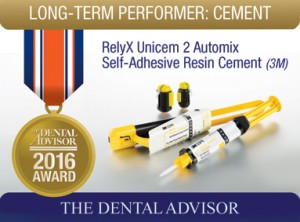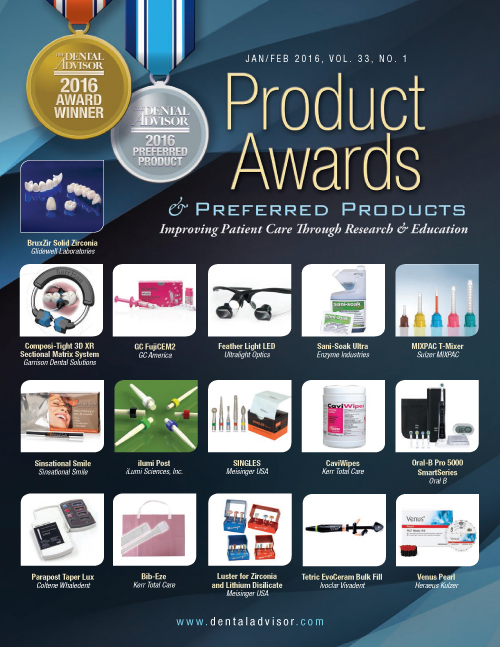Clinical Evaluations
3M RelyX Unicem Self-Adhesive Resin Cement (10 yr)
Consultants’ Comments
- “Using RelyX Unicem, I am confident in getting good retention.”
- “We use RelyX Unicem more often than any other cement in the clinic.”
- “In 10 years of using RelyX Unicem, it really has proven itself.”
- “What’s not to like about RelyX Unicem?”
Description
3M ESPE RelyX Unicem Self-Adhesive Resin Cement is a dual-cured resin cement. It is self adhesive, requiring no separate etching, priming or bonding. The cement is filled 72% by weight and contains fluoride. RelyX Unicem is available in two capsule sizes (Aplicap and Maxicap) in shades A1, A2, A3 Opaque, white opaque, and translucent. An upgraded version of RelyX Unicem, called RelyX Unicem 2 is also available in a paste/paste formulation delivered through the Clicker or an automix syringe. RelyX Unicem is indicated for the cementation of all-ceramic restorations, PFM and metal restorations, crowns, bridges, inlays, onlays, implant abutments and endodontic posts. It is also recommended for cementing CAD/CAM restorations. The Aplicaps have enough material to cement one or two restorations, while the Maxicaps have enough material for three to six restorations.
Clinical Evaluation Protocol
• More than 6000 restorations have been cemented with RelyX Unicem over the past 10 years.
• The restorations include ceramic inlays, onlays, bridges, PFM crowns, zirconia crowns, posts, and CAD/CAM restorations (Figure 1).
• 1,311 anterior and posterior restorations were available for 10-year recall over a six-month period (Figure 2).
• Categories evaluated at recall included: post-operative sensitivity, marginal discoloration, and retention.
• The majority of the posterior restorations were crowns, whereas 10% were onlays, and 2% were bridges (Figure 3).
• Each category was rated on a scale of 1-5: 1=poor, 2=fair, 3=good, 4=very good, 5=excellent.
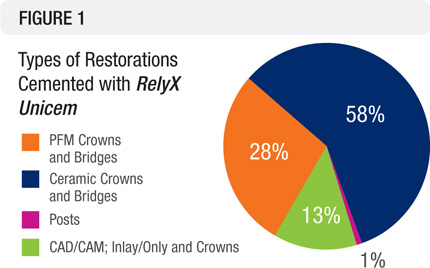
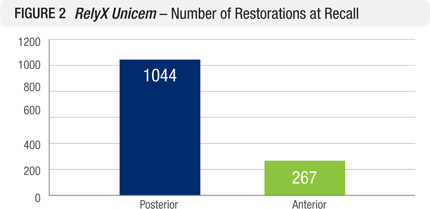
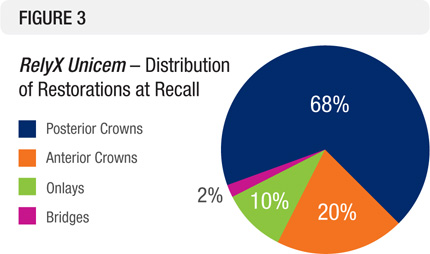
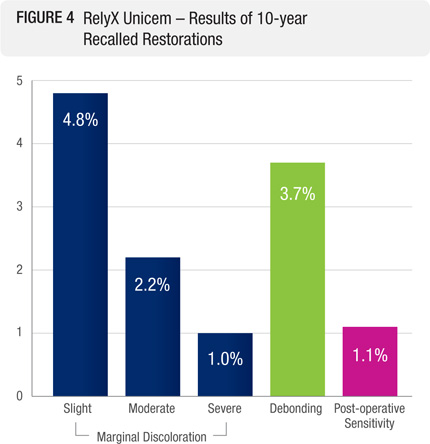
Clinical Observations
Post-operative Sensitivity
Since its introduction, RelyX Unicem has had very few reported instances of post-operative sensitivity (Figure 4). The postoperative sensitivity was 1.1% of the seated restorations and usually occurred shortly after cementation. In most cases, the sensitivity subsided within weeks after cementing the restoration.
Marginal Discoloration
Ninety-two percent of the restorations recalled showed no marginal discoloration (Figure 4). Discoloration at the margin was exhibited by graying at the margin of ceramic restorations. Graying at the margins was observed in 8% of the restorations; 4.8% of the restorations exhibited slight discoloration, 2.2 %
exhibited moderate discoloration while 1% exhibited severe discoloration and required replacement (Figure 4). The rate of marginal discoloration of restorations cemented with RelyX Unicem is comparable to restorations cemented with 5th– and 6th-generation bonding agents and corresponding light- or dual-cured resin cements.
Debonding
Forty-nine (3.7%) of the recalled restorations debonded over the 10-year evaluation period (Figure 4). In 90% of the debonds, most of the cement was in the restoration and not on the prepared tooth. It was also noted that about 20% of the prepared teeth exhibited greying or blackening of the tooth surface. This type of discoloration is commonly seen underneath restorations cemented with adhesive resin cements. The discoloration could be due to bacteria.
Summary
RelyX Unicem has proven to be a reliable, self-adhesive resin cement over the 10-year recall period. This product received a 98% clinical rating.

